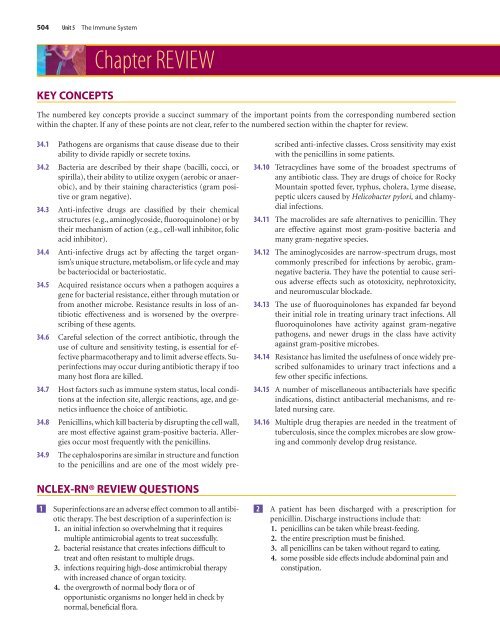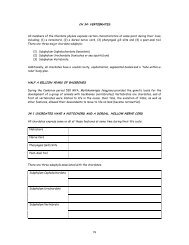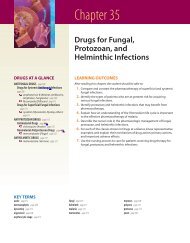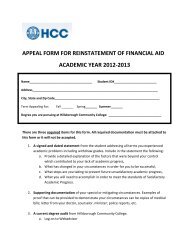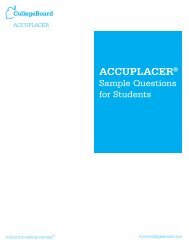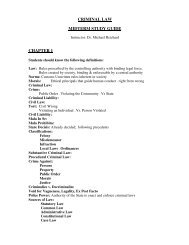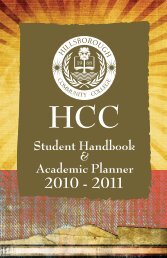Antimicrobial Drugs
Antimicrobial Drugs
Antimicrobial Drugs
Create successful ePaper yourself
Turn your PDF publications into a flip-book with our unique Google optimized e-Paper software.
M34_ADAM9811_03_SE_CH34.QXD 12/30/09 1:16 PM Page 504<br />
504 Unit 5 The Immune System<br />
KEY CONCEPTS<br />
Chapter REVIEW<br />
The numbered key concepts provide a succinct summary of the important points from the corresponding numbered section<br />
within the chapter. If any of these points are not clear, refer to the numbered section within the chapter for review.<br />
34.1 Pathogens are organisms that cause disease due to their<br />
ability to divide rapidly or secrete toxins.<br />
34.2 Bacteria are described by their shape (bacilli, cocci, or<br />
spirilla), their ability to utilize oxygen (aerobic or anaerobic),<br />
and by their staining characteristics (gram positive<br />
or gram negative).<br />
34.3 Anti-infective drugs are classified by their chemical<br />
structures (e.g., aminoglycoside, fluoroquinolone) or by<br />
their mechanism of action (e.g., cell-wall inhibitor, folic<br />
acid inhibitor).<br />
34.4 Anti-infective drugs act by affecting the target organism’s<br />
unique structure, metabolism, or life cycle and may<br />
be bacteriocidal or bacteriostatic.<br />
34.5 Acquired resistance occurs when a pathogen acquires a<br />
gene for bacterial resistance, either through mutation or<br />
from another microbe. Resistance results in loss of antibiotic<br />
effectiveness and is worsened by the overprescribing<br />
of these agents.<br />
34.6 Careful selection of the correct antibiotic, through the<br />
use of culture and sensitivity testing, is essential for effective<br />
pharmacotherapy and to limit adverse effects. Superinfections<br />
may occur during antibiotic therapy if too<br />
many host flora are killed.<br />
34.7 Host factors such as immune system status, local conditions<br />
at the infection site, allergic reactions, age, and genetics<br />
influence the choice of antibiotic.<br />
34.8 Penicillins, which kill bacteria by disrupting the cell wall,<br />
are most effective against gram-positive bacteria. Allergies<br />
occur most frequently with the penicillins.<br />
34.9 The cephalosporins are similar in structure and function<br />
to the penicillins and are one of the most widely prescribed<br />
anti-infective classes. Cross sensitivity may exist<br />
with the penicillins in some patients.<br />
34.10 Tetracyclines have some of the broadest spectrums of<br />
any antibiotic class. They are drugs of choice for Rocky<br />
Mountain spotted fever, typhus, cholera, Lyme disease,<br />
peptic ulcers caused by Helicobacter pylori, and chlamydial<br />
infections.<br />
34.11 The macrolides are safe alternatives to penicillin. They<br />
are effective against most gram-positive bacteria and<br />
many gram-negative species.<br />
34.12 The aminoglycosides are narrow-spectrum drugs, most<br />
commonly prescribed for infections by aerobic, gramnegative<br />
bacteria. They have the potential to cause serious<br />
adverse effects such as ototoxicity, nephrotoxicity,<br />
and neuromuscular blockade.<br />
34.13 The use of fluoroquinolones has expanded far beyond<br />
their initial role in treating urinary tract infections. All<br />
fluoroquinolones have activity against gram-negative<br />
pathogens, and newer drugs in the class have activity<br />
against gram-positive microbes.<br />
34.14 Resistance has limited the usefulness of once widely prescribed<br />
sulfonamides to urinary tract infections and a<br />
few other specific infections.<br />
34.15 A number of miscellaneous antibacterials have specific<br />
indications, distinct antibacterial mechanisms, and related<br />
nursing care.<br />
34.16 Multiple drug therapies are needed in the treatment of<br />
tuberculosis, since the complex microbes are slow growing<br />
and commonly develop drug resistance.<br />
NCLEX-RN® REVIEW QUESTIONS<br />
1 Superinfections are an adverse effect common to all antibiotic<br />
therapy. The best description of a superinfection is:<br />
1. an initial infection so overwhelming that it requires<br />
multiple antimicrobial agents to treat successfully.<br />
2. bacterial resistance that creates infections difficult to<br />
treat and often resistant to multiple drugs.<br />
3. infections requiring high-dose antimicrobial therapy<br />
with increased chance of organ toxicity.<br />
4. the overgrowth of normal body flora or of<br />
opportunistic organisms no longer held in check by<br />
normal, beneficial flora.<br />
2 A patient has been discharged with a prescription for<br />
penicillin. Discharge instructions include that:<br />
1. penicillins can be taken while breast-feeding.<br />
2. the entire prescription must be finished.<br />
3. all penicillins can be taken without regard to eating.<br />
4. some possible side effects include abdominal pain and<br />
constipation.<br />
# 102887 Cust: PE/NJ/CHET Au: ADAMS Pg. No. 504<br />
Title: Pharmacology for Nurses Server: Jobs2<br />
C/M/Y/K<br />
Short / Normal<br />
DESIGN SERVICES OF<br />
S4CARLISLE<br />
Publishing Services


